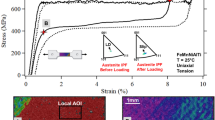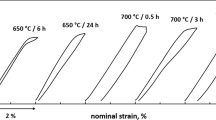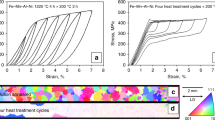Abstract
Among all shape memory alloys, the iron-based FeMnNiAl has emerged as one of the most promising compositions with a huge superelasticity temperature window (> 400 °C). In this article, we first point to the high local transformation strains (> 10%) and high transformation stress levels (500–700 MPa) that result in a large work output. When subjected to either tensile or compressive loading, the transformation stress exhibits very small temperature dependence (Clausius–Clapeyron slope less than 0.2 MPa/°C in compression and 0.5 MPa/°C in tension) and an extremely small adiabatic temperature rise (less than 1 °C) during transformation. The complexity in transformation behavior associated with the presence of grain boundaries (GBs) is discussed. In particular, the work provides insight in the localization occurring at GBs due to transformation front–GB interactions and the potential cracking that can degrade fatigue performance. Overall, this work provides a deeper insight into the deformation response, advantages, and drawbacks of FeMnNiAl SMA. The comprehensive handling of various aspects of this alloy system paves the way for the development of future iron-based shape memory alloys.













Similar content being viewed by others
References
Hornbogen E, Jost N (1991) Alloys of iron and reversibility of martensitic transformations. Le J Phys IV 1:C4-199–C4-210. https://doi.org/10.1051/jp4:1991430
Koval YN, Kokorin VV, Khandros LG (1979) Shape memory effect in Fe-Ni-Co-Ti alloys. Phys Met Met 48:162–164
Maki T, Kobayashi K, Minato M, Tamura I (1984) Thermoelastic martensite in an ausaged Fe-Ni-Ti-Co alloy. Scr Metall 18:1105–1109. https://doi.org/10.1016/0036-9748(84)90187-X
Sehitoglu H, Karaman I, Zhang X et al (2001) Deformation of FeNiCoTi shape memory single crystals. Scr Mater 44:779–784. https://doi.org/10.1016/S1359-6462(00)00657-6
Sehitoglu H, Zhang XY, Kotil T et al (2002) Shape memory behavior of FeNiCoTi single and polycrystals. Metall Mater Trans A 33:3661–3672. https://doi.org/10.1007/s11661-002-0240-0
Sehitoglu H, Efstathiou C, Maier HJ, Chumlyakov Y (2005) Magnetization, shape memory and hysteresis behavior of single and polycrystalline FeNiCoTi. J Magn Magn Mater 292:89–99. https://doi.org/10.1016/J.JMMM.2004.10.101
Abuzaid W, Sehitoglu H (2018) Superelasticity and functional fatigue of single crystalline FeNiCoAlTi iron-based shape memory alloy. Mater Des 160:642–651. https://doi.org/10.1016/J.MATDES.2018.10.003
Chen Q, Andrawes B, Sehitoglu H (2014) Thermomechanical testing of FeNiCoTi shape memory alloy for active confinement of concrete. Smart Mater Struct 23:055015. https://doi.org/10.1088/0964-1726/23/5/055015
Kuts OA, Panchenko MY, Kireeva IV, Chumlyakov YI (2015) Shape Memory Effect and Superelasticity in [001] Single Crystals of FeNiCoAlNb(B) Alloys. IOP Conf Ser Mater Sci Eng 93:012034. https://doi.org/10.1088/1757-899X/93/1/012034
Chumlyakov YI, Kireeva IV, Kutz OA et al (2016) Unusual reversible twinning modes and giant superelastic strains in FeNiCoAlNb single crystals. Scr Mater 119:43–46. https://doi.org/10.1016/J.SCRIPTAMAT.2016.03.027
Omori T, Ando K, Okano M et al (2011) Superelastic effect in polycrystalline ferrous alloys. Science 80(333):68–71. https://doi.org/10.1126/science.1202232
Tanaka Y, Himuro Y, Kainuma R et al (2010) Ferrous polycrystalline shape-memory. Science 327(5972):1488–1491
Wang J, Sehitoglu H (2014) Dislocation slip and twinning in Ni-based L12 type alloys. Intermetallics 52:20–31. https://doi.org/10.1016/J.INTERMET.2014.03.009
Tseng LW, Ma J, Wang SJ et al (2015) Superelastic response of a single crystalline FeMnAlNi shape memory alloy under tension and compression. Acta Mater 89:374–383. https://doi.org/10.1016/J.ACTAMAT.2015.01.009
Vollmer M, Krooß P, Kriegel MJ et al (2016) Cyclic degradation in bamboo-like Fe–Mn–Al–Ni shape memory alloys—The role of grain orientation. Scr Mater 114:156–160. https://doi.org/10.1016/J.SCRIPTAMAT.2015.12.007
Vollmer M, Segel C, Krooß P et al (2015) On the effect of gamma phase formation on the pseudoelastic performance of polycrystalline Fe–Mn–Al–Ni shape memory alloys. Scr Mater 108:23–26. https://doi.org/10.1016/J.SCRIPTAMAT.2015.06.013
Sato A, Chishima E, Soma K, Mori T (1982) Shape memory effect in γ⇄ϵ transformation in Fe-30Mn-1Si alloy single crystals. Acta Metall 30:1177–1183. https://doi.org/10.1016/0001-6160(82)90011-6
Watanabe Y, Mori Y, Sato A (1993) Training effect in Fe-Mn-Si shape-memory alloys. J Mater Sci 28:1509–1514. https://doi.org/10.1007/BF00363341
Karaca HE, Turabi AS, Chumlyakov YI et al (2016) Superelasticity of [001]-oriented Fe42·6Ni27.9Co17·2Al9.9Nb2.4 ferrous shape memory alloys. Scr Mater 120:54–57. https://doi.org/10.1016/J.SCRIPTAMAT.2016.04.008
Ma J, Hornbuckle BC, Karaman I et al (2013) The effect of nanoprecipitates on the superelastic properties of FeNiCoAlTa shape memory alloy single crystals. Acta Mater 61:3445–3455. https://doi.org/10.1016/J.ACTAMAT.2013.02.036
Krooß P, Vollmer M, Somsen C, et al (2017) Functional properties of Fe-based shape memory alloys containing finely dispersed precipitates. In: SMAR 2017 - Fourth conference on smart monitoring, assessment and rehabilitation of civil structures. pp 2–9
Ojha A, Sehitoglu H (2016) Transformation stress modeling in new Fe-Mn-Al-Ni shape memory alloy. Int J Plast 86:93–111. https://doi.org/10.1016/j.ijplas.2016.08.003
Krooß P, Kadletz PM, Somsen C et al (2016) Cyclic degradation of Co49Ni21Ga30 high-temperature shape memory alloy: on the roles of dislocation activity and chemical order. Shap Mem Superelasticity 2:37–49. https://doi.org/10.1007/s40830-015-0049-5
Chumlyakov YI, Kireeva IV, Panchenko EY et al (2008) High-temperature superelasticity in CoNiGa, CoNiAl, NiFeGa, and TiNi monocrystals. Russ Phys J 51:1016–1036. https://doi.org/10.1007/s11182-009-9143-5
Zhang Y, You Y, Moumni Z et al (2017) Experimental and theoretical investigation of the frequency effect on low cycle fatigue of shape memory alloys. Int J Plast 90:1–30. https://doi.org/10.1016/J.IJPLAS.2016.11.012
Nemat-Nasser S, Choi J-Y, Guo W-G, Isaacs JB (2005) Very high strain-rate response of a NiTi shape-memory alloy. Mech Mater 37:287–298. https://doi.org/10.1016/J.MECHMAT.2004.03.007
Omori T, Kainuma R (2017) Martensitic transformation and superelasticity in Fe–Mn–Al-based shape memory alloys. Shape Mem Superelasticity 3:322–334. https://doi.org/10.1007/s40830-017-0129-9
Vollmer M, Kriegel MJ, Walnsch A et al (2019) On the microstructural and functional stability of Fe-Mn-Al-Ni at ambient and elevated temperatures. Scr Mater 162:442–446. https://doi.org/10.1016/J.SCRIPTAMAT.2018.12.008
Vollmer M, Kriegel MJ, Krooß P et al (2017) Cyclic degradation behavior of 〈001〉-oriented Fe–Mn–Al–Ni single crystals in tension. Shape Mem Superelasticity 3:335–346. https://doi.org/10.1007/s40830-017-0117-0
Ozcan H, Ma J, Wang SJ et al (2017) Effects of cyclic heat treatment and aging on superelasticity in oligocrystalline Fe-Mn-Al-Ni shape memory alloy wires. Scr Mater 134:66–70. https://doi.org/10.1016/j.scriptamat.2017.02.023
Ozcan H, Ma J, Karaman I et al (2018) Microstructural design considerations in Fe-Mn-Al-Ni shape memory alloy wires: effects of natural aging. Scr Mater 142:153–157. https://doi.org/10.1016/J.SCRIPTAMAT.2017.07.033
Acknowledgements
The work is supported by Nyquist Chair Funds of University of Illinois. Specimen preparation by FIB and TEM analyses were carried out in the Frederick Seitz Materials Research Laboratory Central Research Facilities, University of Illinois. Financial support by the German Research Foundation (Project No. 250216343 (NI1327/7-3)) and by University of Kassel provided in the framework of the project SmartCon is gratefully acknowledged.
Author information
Authors and Affiliations
Corresponding authors
Additional information
Publisher's Note
Springer Nature remains neutral with regard to jurisdictional claims in published maps and institutional affiliations.
Electronic Supplementary Material
Below is the link to the electronic supplementary material.
Rights and permissions
About this article
Cite this article
Abuzaid, W., Wu, Y., Sidharth, R. et al. FeMnNiAl Iron-Based Shape Memory Alloy: Promises and Challenges. Shap. Mem. Superelasticity 5, 263–277 (2019). https://doi.org/10.1007/s40830-019-00230-9
Published:
Issue Date:
DOI: https://doi.org/10.1007/s40830-019-00230-9




